Health Promotion Report: Government Strategies and Models in UK
VerifiedAdded on 2019/12/03
|15
|5111
|250
Report
AI Summary
This report comprehensively examines health promotion within the UK context, exploring the multifaceted influences on public health. It begins by analyzing the socio-economic factors, such as unemployment, lifestyle choices, discrimination, and access to education and healthcare, that significantly impact health outcomes in the London Borough. The report then delves into the relevance of government sources, including the Black Report, Acheson Report, Marmot Report, and NICE, in reporting health inequalities. It identifies key barriers to healthcare access, such as location, income, trust, and mental capacity. Furthermore, the report links government strategies, including 'Healthy Lives and Healthy People 2010' and various campaigns, to health promotion models like Beattie's, Tones and Tilford’s, and Caplan and Holland’s. The crucial role of health professionals, particularly smoking cessation officers, in achieving government targets is also highlighted, detailing their responsibilities in counseling, awareness campaigns, and follow-up programs. The report concludes by planning a health promotion campaign.
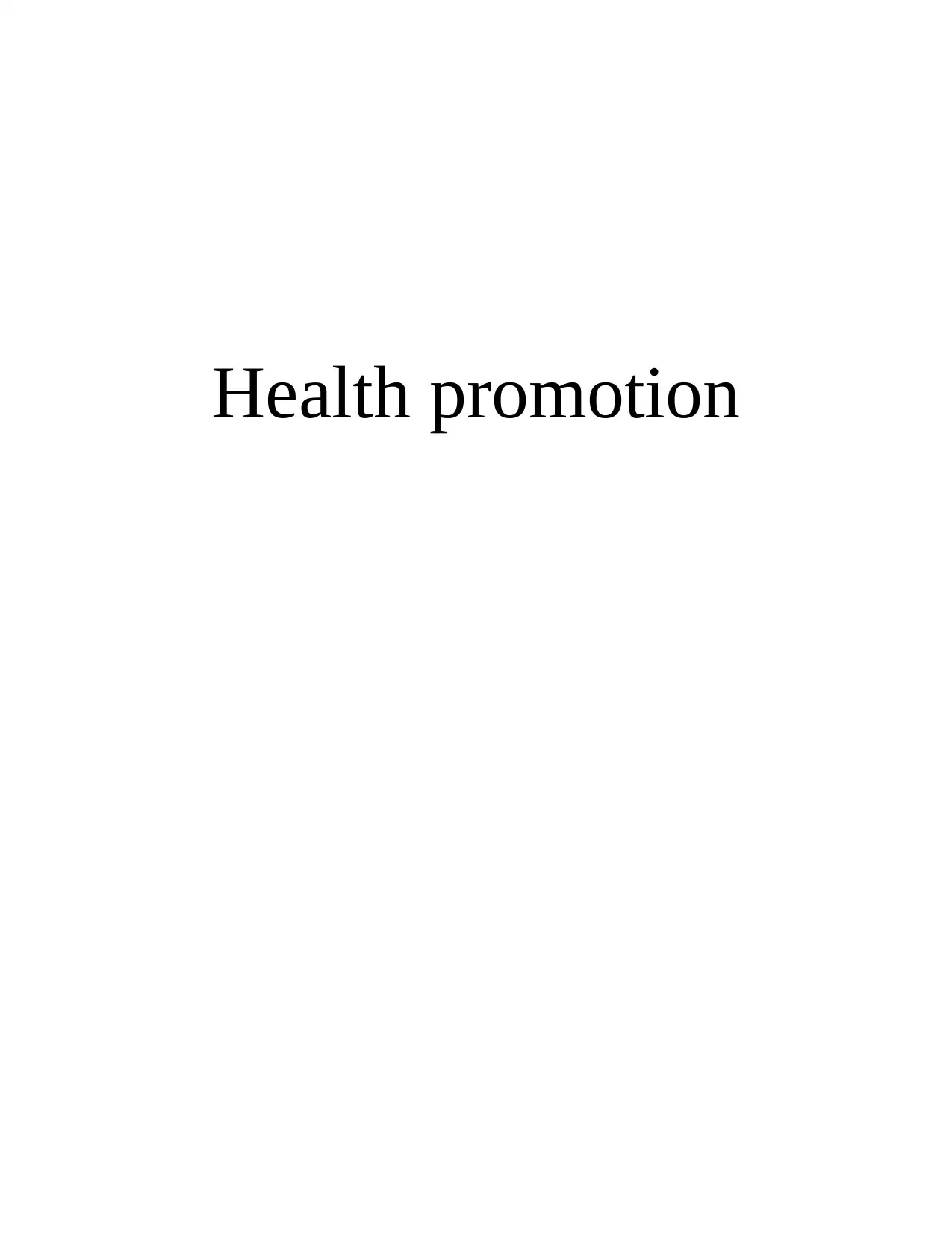
Health promotion
Paraphrase This Document
Need a fresh take? Get an instant paraphrase of this document with our AI Paraphraser
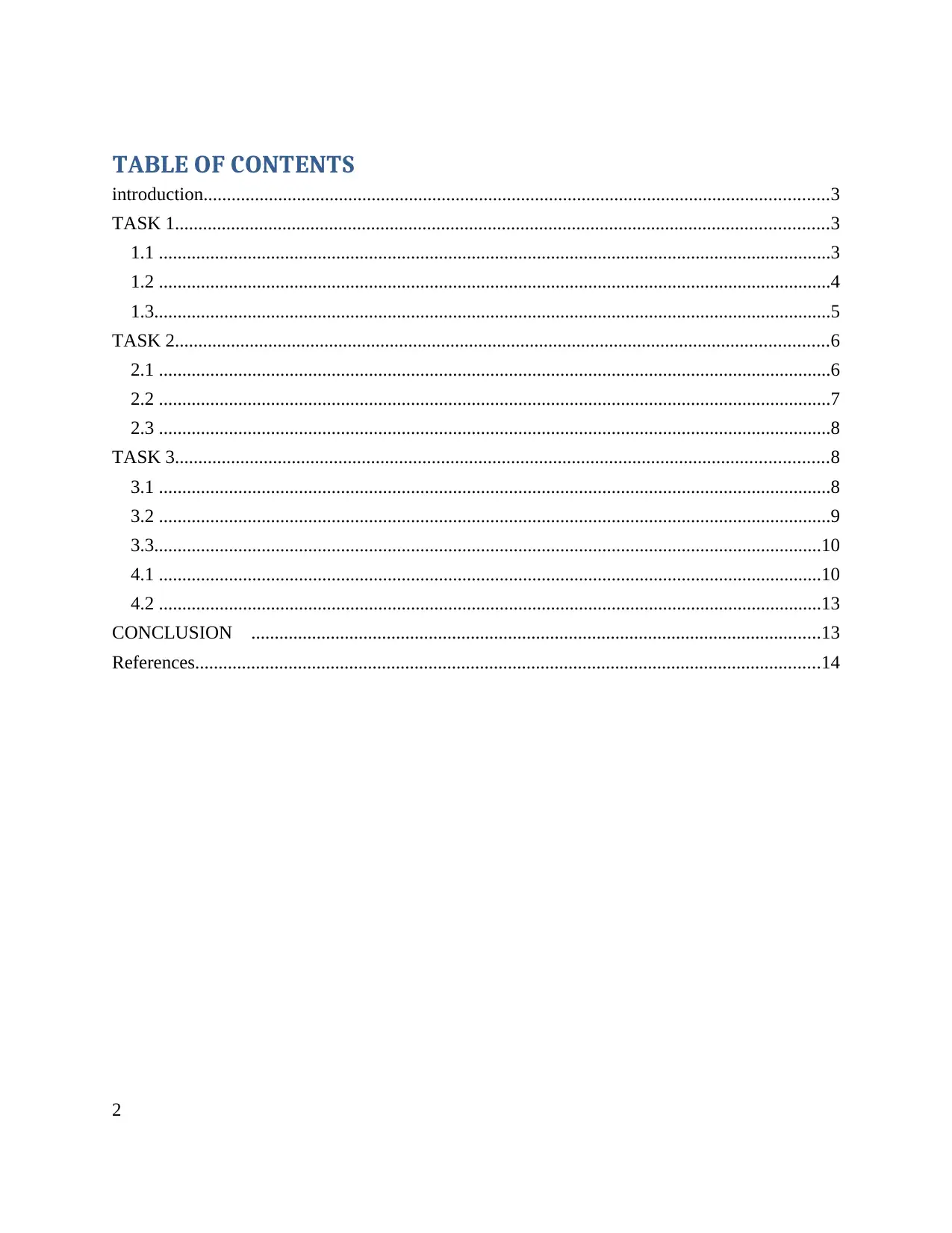
TABLE OF CONTENTS
introduction......................................................................................................................................3
TASK 1............................................................................................................................................3
1.1 ................................................................................................................................................3
1.2 ................................................................................................................................................4
1.3.................................................................................................................................................5
TASK 2............................................................................................................................................6
2.1 ................................................................................................................................................6
2.2 ................................................................................................................................................7
2.3 ................................................................................................................................................8
TASK 3............................................................................................................................................8
3.1 ................................................................................................................................................8
3.2 ................................................................................................................................................9
3.3...............................................................................................................................................10
4.1 ..............................................................................................................................................10
4.2 ..............................................................................................................................................13
CONCLUSION ..........................................................................................................................13
References......................................................................................................................................14
2
introduction......................................................................................................................................3
TASK 1............................................................................................................................................3
1.1 ................................................................................................................................................3
1.2 ................................................................................................................................................4
1.3.................................................................................................................................................5
TASK 2............................................................................................................................................6
2.1 ................................................................................................................................................6
2.2 ................................................................................................................................................7
2.3 ................................................................................................................................................8
TASK 3............................................................................................................................................8
3.1 ................................................................................................................................................8
3.2 ................................................................................................................................................9
3.3...............................................................................................................................................10
4.1 ..............................................................................................................................................10
4.2 ..............................................................................................................................................13
CONCLUSION ..........................................................................................................................13
References......................................................................................................................................14
2
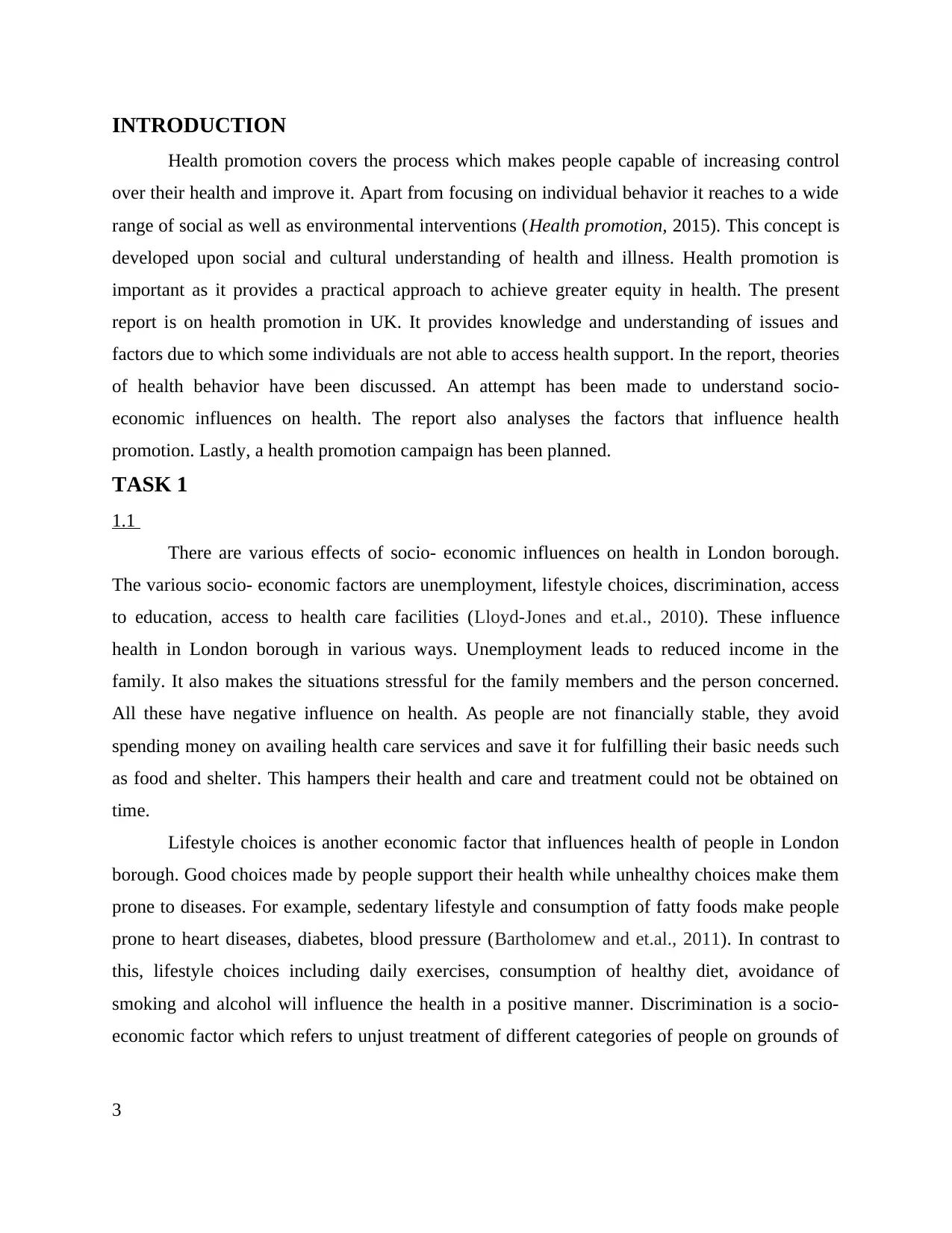
INTRODUCTION
Health promotion covers the process which makes people capable of increasing control
over their health and improve it. Apart from focusing on individual behavior it reaches to a wide
range of social as well as environmental interventions (Health promotion, 2015). This concept is
developed upon social and cultural understanding of health and illness. Health promotion is
important as it provides a practical approach to achieve greater equity in health. The present
report is on health promotion in UK. It provides knowledge and understanding of issues and
factors due to which some individuals are not able to access health support. In the report, theories
of health behavior have been discussed. An attempt has been made to understand socio-
economic influences on health. The report also analyses the factors that influence health
promotion. Lastly, a health promotion campaign has been planned.
TASK 1
1.1
There are various effects of socio- economic influences on health in London borough.
The various socio- economic factors are unemployment, lifestyle choices, discrimination, access
to education, access to health care facilities (Lloyd-Jones and et.al., 2010). These influence
health in London borough in various ways. Unemployment leads to reduced income in the
family. It also makes the situations stressful for the family members and the person concerned.
All these have negative influence on health. As people are not financially stable, they avoid
spending money on availing health care services and save it for fulfilling their basic needs such
as food and shelter. This hampers their health and care and treatment could not be obtained on
time.
Lifestyle choices is another economic factor that influences health of people in London
borough. Good choices made by people support their health while unhealthy choices make them
prone to diseases. For example, sedentary lifestyle and consumption of fatty foods make people
prone to heart diseases, diabetes, blood pressure (Bartholomew and et.al., 2011). In contrast to
this, lifestyle choices including daily exercises, consumption of healthy diet, avoidance of
smoking and alcohol will influence the health in a positive manner. Discrimination is a socio-
economic factor which refers to unjust treatment of different categories of people on grounds of
3
Health promotion covers the process which makes people capable of increasing control
over their health and improve it. Apart from focusing on individual behavior it reaches to a wide
range of social as well as environmental interventions (Health promotion, 2015). This concept is
developed upon social and cultural understanding of health and illness. Health promotion is
important as it provides a practical approach to achieve greater equity in health. The present
report is on health promotion in UK. It provides knowledge and understanding of issues and
factors due to which some individuals are not able to access health support. In the report, theories
of health behavior have been discussed. An attempt has been made to understand socio-
economic influences on health. The report also analyses the factors that influence health
promotion. Lastly, a health promotion campaign has been planned.
TASK 1
1.1
There are various effects of socio- economic influences on health in London borough.
The various socio- economic factors are unemployment, lifestyle choices, discrimination, access
to education, access to health care facilities (Lloyd-Jones and et.al., 2010). These influence
health in London borough in various ways. Unemployment leads to reduced income in the
family. It also makes the situations stressful for the family members and the person concerned.
All these have negative influence on health. As people are not financially stable, they avoid
spending money on availing health care services and save it for fulfilling their basic needs such
as food and shelter. This hampers their health and care and treatment could not be obtained on
time.
Lifestyle choices is another economic factor that influences health of people in London
borough. Good choices made by people support their health while unhealthy choices make them
prone to diseases. For example, sedentary lifestyle and consumption of fatty foods make people
prone to heart diseases, diabetes, blood pressure (Bartholomew and et.al., 2011). In contrast to
this, lifestyle choices including daily exercises, consumption of healthy diet, avoidance of
smoking and alcohol will influence the health in a positive manner. Discrimination is a socio-
economic factor which refers to unjust treatment of different categories of people on grounds of
3
⊘ This is a preview!⊘
Do you want full access?
Subscribe today to unlock all pages.

Trusted by 1+ million students worldwide
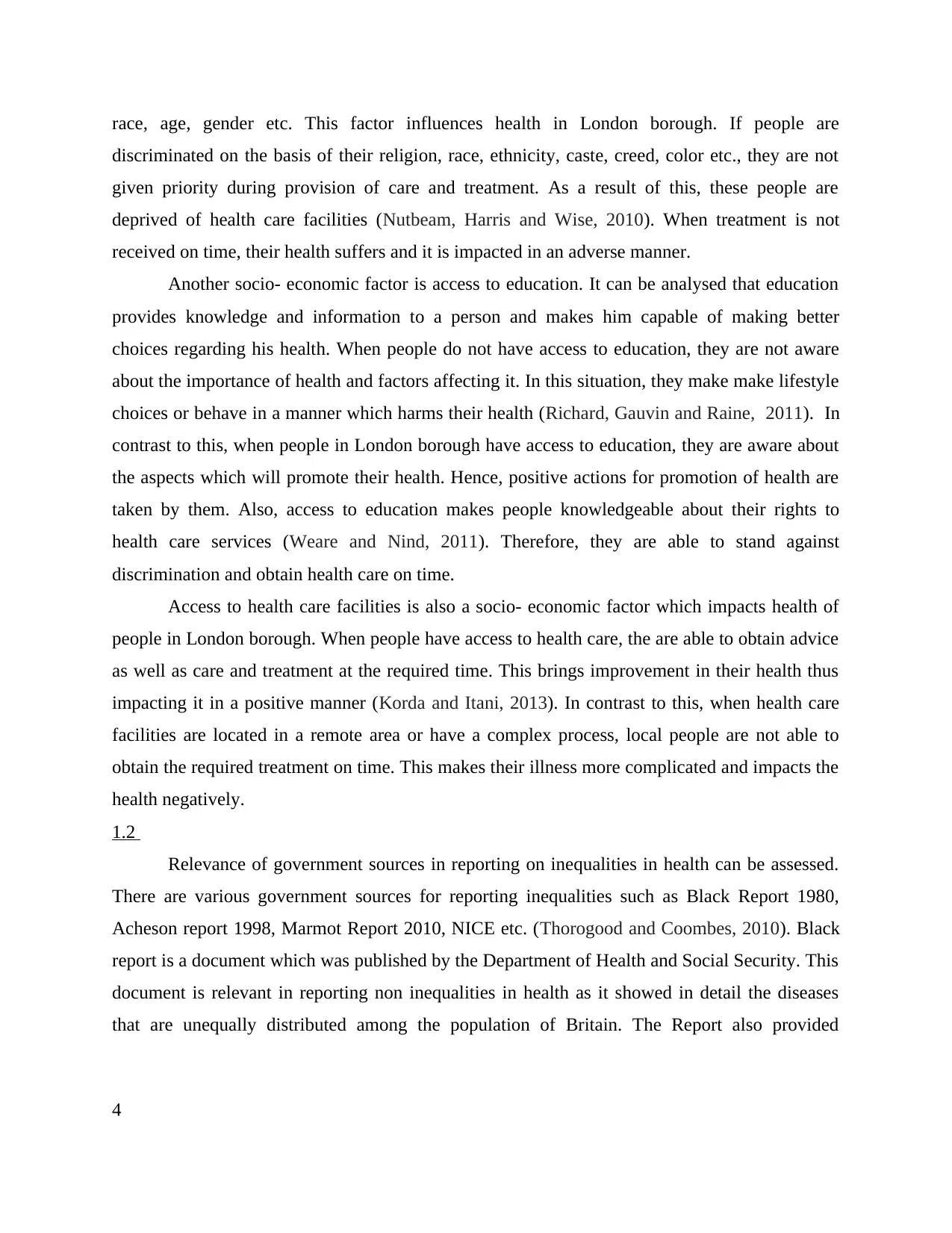
race, age, gender etc. This factor influences health in London borough. If people are
discriminated on the basis of their religion, race, ethnicity, caste, creed, color etc., they are not
given priority during provision of care and treatment. As a result of this, these people are
deprived of health care facilities (Nutbeam, Harris and Wise, 2010). When treatment is not
received on time, their health suffers and it is impacted in an adverse manner.
Another socio- economic factor is access to education. It can be analysed that education
provides knowledge and information to a person and makes him capable of making better
choices regarding his health. When people do not have access to education, they are not aware
about the importance of health and factors affecting it. In this situation, they make make lifestyle
choices or behave in a manner which harms their health (Richard, Gauvin and Raine, 2011). In
contrast to this, when people in London borough have access to education, they are aware about
the aspects which will promote their health. Hence, positive actions for promotion of health are
taken by them. Also, access to education makes people knowledgeable about their rights to
health care services (Weare and Nind, 2011). Therefore, they are able to stand against
discrimination and obtain health care on time.
Access to health care facilities is also a socio- economic factor which impacts health of
people in London borough. When people have access to health care, the are able to obtain advice
as well as care and treatment at the required time. This brings improvement in their health thus
impacting it in a positive manner (Korda and Itani, 2013). In contrast to this, when health care
facilities are located in a remote area or have a complex process, local people are not able to
obtain the required treatment on time. This makes their illness more complicated and impacts the
health negatively.
1.2
Relevance of government sources in reporting on inequalities in health can be assessed.
There are various government sources for reporting inequalities such as Black Report 1980,
Acheson report 1998, Marmot Report 2010, NICE etc. (Thorogood and Coombes, 2010). Black
report is a document which was published by the Department of Health and Social Security. This
document is relevant in reporting non inequalities in health as it showed in detail the diseases
that are unequally distributed among the population of Britain. The Report also provided
4
discriminated on the basis of their religion, race, ethnicity, caste, creed, color etc., they are not
given priority during provision of care and treatment. As a result of this, these people are
deprived of health care facilities (Nutbeam, Harris and Wise, 2010). When treatment is not
received on time, their health suffers and it is impacted in an adverse manner.
Another socio- economic factor is access to education. It can be analysed that education
provides knowledge and information to a person and makes him capable of making better
choices regarding his health. When people do not have access to education, they are not aware
about the importance of health and factors affecting it. In this situation, they make make lifestyle
choices or behave in a manner which harms their health (Richard, Gauvin and Raine, 2011). In
contrast to this, when people in London borough have access to education, they are aware about
the aspects which will promote their health. Hence, positive actions for promotion of health are
taken by them. Also, access to education makes people knowledgeable about their rights to
health care services (Weare and Nind, 2011). Therefore, they are able to stand against
discrimination and obtain health care on time.
Access to health care facilities is also a socio- economic factor which impacts health of
people in London borough. When people have access to health care, the are able to obtain advice
as well as care and treatment at the required time. This brings improvement in their health thus
impacting it in a positive manner (Korda and Itani, 2013). In contrast to this, when health care
facilities are located in a remote area or have a complex process, local people are not able to
obtain the required treatment on time. This makes their illness more complicated and impacts the
health negatively.
1.2
Relevance of government sources in reporting on inequalities in health can be assessed.
There are various government sources for reporting inequalities such as Black Report 1980,
Acheson report 1998, Marmot Report 2010, NICE etc. (Thorogood and Coombes, 2010). Black
report is a document which was published by the Department of Health and Social Security. This
document is relevant in reporting non inequalities in health as it showed in detail the diseases
that are unequally distributed among the population of Britain. The Report also provided
4
Paraphrase This Document
Need a fresh take? Get an instant paraphrase of this document with our AI Paraphraser
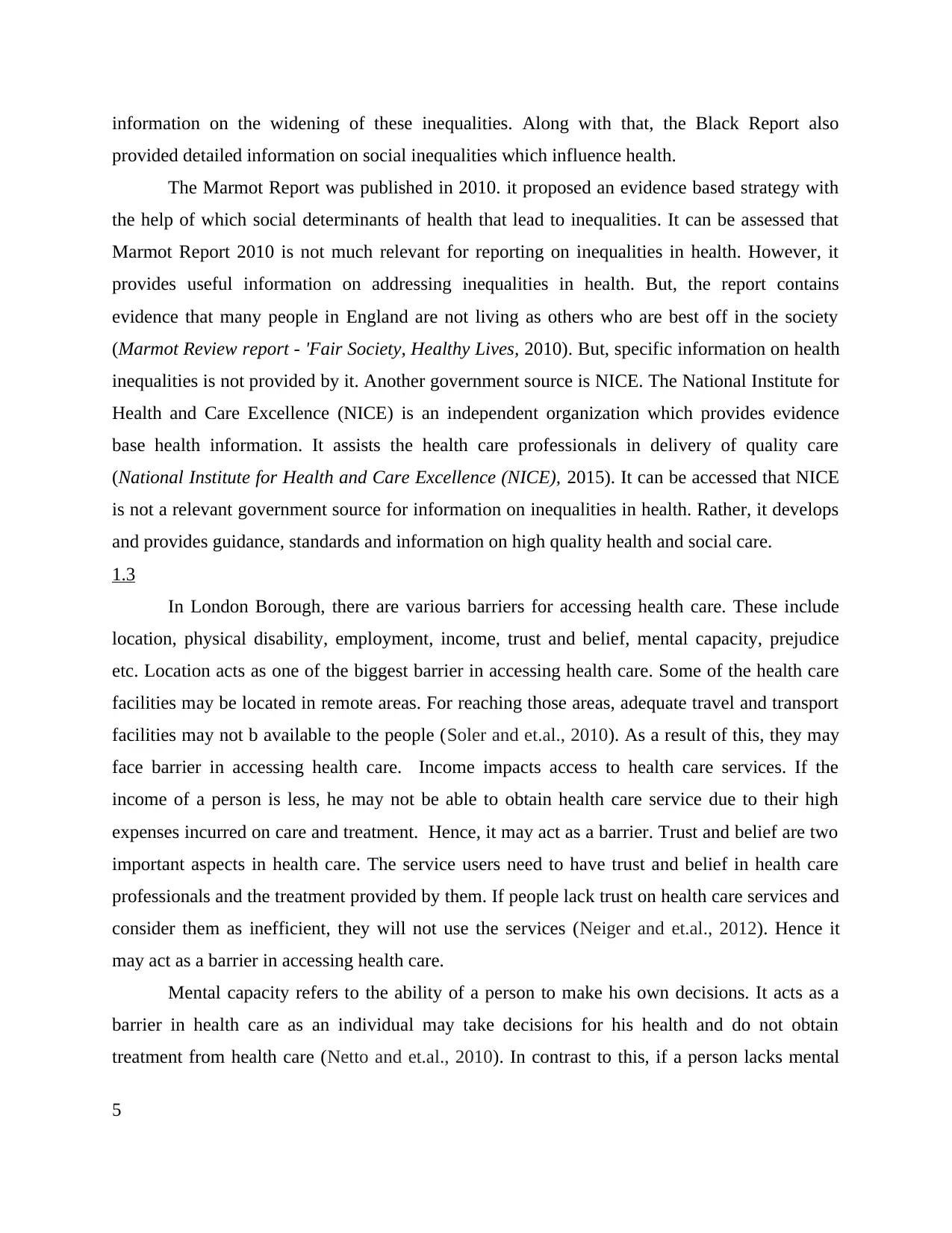
information on the widening of these inequalities. Along with that, the Black Report also
provided detailed information on social inequalities which influence health.
The Marmot Report was published in 2010. it proposed an evidence based strategy with
the help of which social determinants of health that lead to inequalities. It can be assessed that
Marmot Report 2010 is not much relevant for reporting on inequalities in health. However, it
provides useful information on addressing inequalities in health. But, the report contains
evidence that many people in England are not living as others who are best off in the society
(Marmot Review report - 'Fair Society, Healthy Lives, 2010). But, specific information on health
inequalities is not provided by it. Another government source is NICE. The National Institute for
Health and Care Excellence (NICE) is an independent organization which provides evidence
base health information. It assists the health care professionals in delivery of quality care
(National Institute for Health and Care Excellence (NICE), 2015). It can be accessed that NICE
is not a relevant government source for information on inequalities in health. Rather, it develops
and provides guidance, standards and information on high quality health and social care.
1.3
In London Borough, there are various barriers for accessing health care. These include
location, physical disability, employment, income, trust and belief, mental capacity, prejudice
etc. Location acts as one of the biggest barrier in accessing health care. Some of the health care
facilities may be located in remote areas. For reaching those areas, adequate travel and transport
facilities may not b available to the people (Soler and et.al., 2010). As a result of this, they may
face barrier in accessing health care. Income impacts access to health care services. If the
income of a person is less, he may not be able to obtain health care service due to their high
expenses incurred on care and treatment. Hence, it may act as a barrier. Trust and belief are two
important aspects in health care. The service users need to have trust and belief in health care
professionals and the treatment provided by them. If people lack trust on health care services and
consider them as inefficient, they will not use the services (Neiger and et.al., 2012). Hence it
may act as a barrier in accessing health care.
Mental capacity refers to the ability of a person to make his own decisions. It acts as a
barrier in health care as an individual may take decisions for his health and do not obtain
treatment from health care (Netto and et.al., 2010). In contrast to this, if a person lacks mental
5
provided detailed information on social inequalities which influence health.
The Marmot Report was published in 2010. it proposed an evidence based strategy with
the help of which social determinants of health that lead to inequalities. It can be assessed that
Marmot Report 2010 is not much relevant for reporting on inequalities in health. However, it
provides useful information on addressing inequalities in health. But, the report contains
evidence that many people in England are not living as others who are best off in the society
(Marmot Review report - 'Fair Society, Healthy Lives, 2010). But, specific information on health
inequalities is not provided by it. Another government source is NICE. The National Institute for
Health and Care Excellence (NICE) is an independent organization which provides evidence
base health information. It assists the health care professionals in delivery of quality care
(National Institute for Health and Care Excellence (NICE), 2015). It can be accessed that NICE
is not a relevant government source for information on inequalities in health. Rather, it develops
and provides guidance, standards and information on high quality health and social care.
1.3
In London Borough, there are various barriers for accessing health care. These include
location, physical disability, employment, income, trust and belief, mental capacity, prejudice
etc. Location acts as one of the biggest barrier in accessing health care. Some of the health care
facilities may be located in remote areas. For reaching those areas, adequate travel and transport
facilities may not b available to the people (Soler and et.al., 2010). As a result of this, they may
face barrier in accessing health care. Income impacts access to health care services. If the
income of a person is less, he may not be able to obtain health care service due to their high
expenses incurred on care and treatment. Hence, it may act as a barrier. Trust and belief are two
important aspects in health care. The service users need to have trust and belief in health care
professionals and the treatment provided by them. If people lack trust on health care services and
consider them as inefficient, they will not use the services (Neiger and et.al., 2012). Hence it
may act as a barrier in accessing health care.
Mental capacity refers to the ability of a person to make his own decisions. It acts as a
barrier in health care as an individual may take decisions for his health and do not obtain
treatment from health care (Netto and et.al., 2010). In contrast to this, if a person lacks mental
5
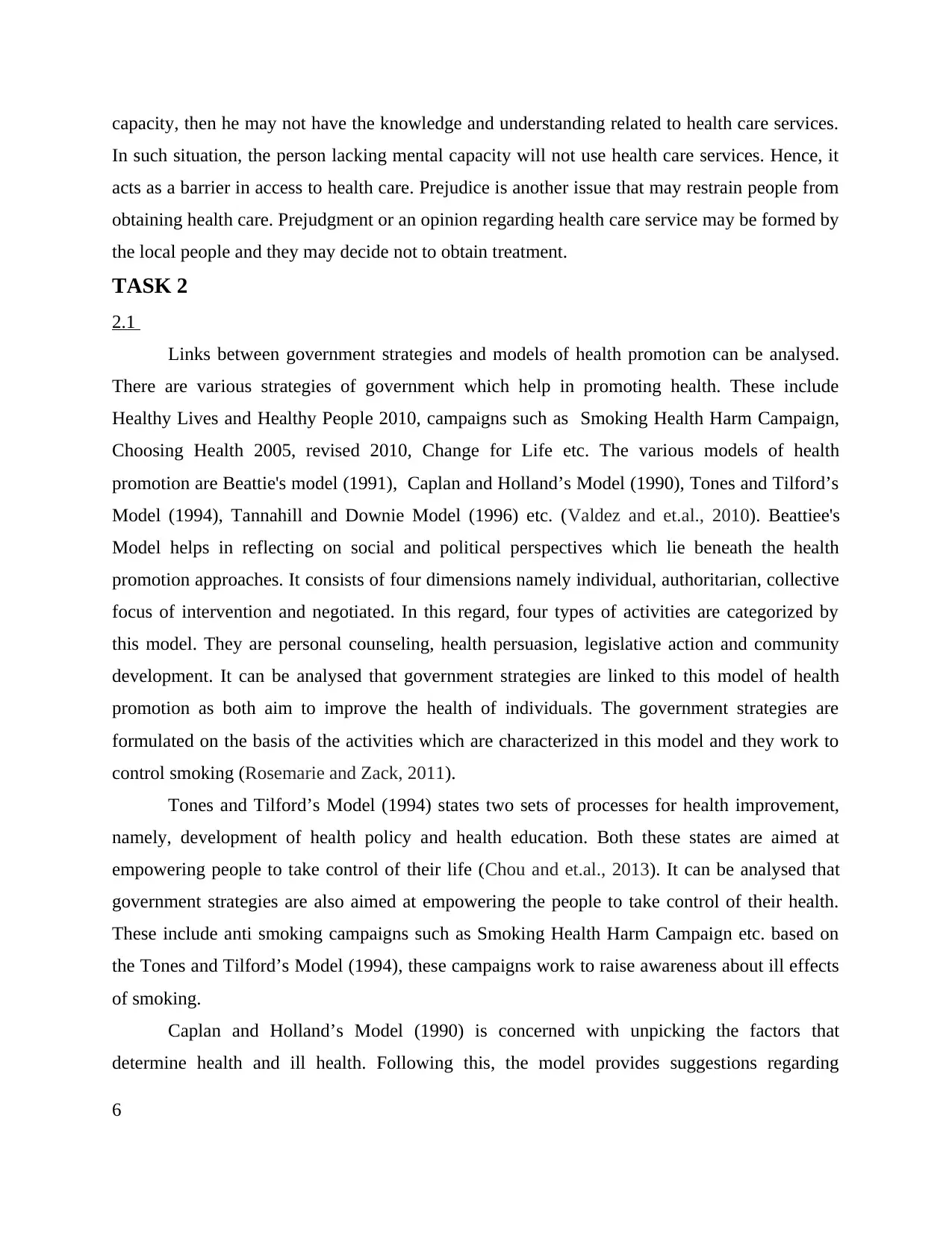
capacity, then he may not have the knowledge and understanding related to health care services.
In such situation, the person lacking mental capacity will not use health care services. Hence, it
acts as a barrier in access to health care. Prejudice is another issue that may restrain people from
obtaining health care. Prejudgment or an opinion regarding health care service may be formed by
the local people and they may decide not to obtain treatment.
TASK 2
2.1
Links between government strategies and models of health promotion can be analysed.
There are various strategies of government which help in promoting health. These include
Healthy Lives and Healthy People 2010, campaigns such as Smoking Health Harm Campaign,
Choosing Health 2005, revised 2010, Change for Life etc. The various models of health
promotion are Beattie's model (1991), Caplan and Holland’s Model (1990), Tones and Tilford’s
Model (1994), Tannahill and Downie Model (1996) etc. (Valdez and et.al., 2010). Beattiee's
Model helps in reflecting on social and political perspectives which lie beneath the health
promotion approaches. It consists of four dimensions namely individual, authoritarian, collective
focus of intervention and negotiated. In this regard, four types of activities are categorized by
this model. They are personal counseling, health persuasion, legislative action and community
development. It can be analysed that government strategies are linked to this model of health
promotion as both aim to improve the health of individuals. The government strategies are
formulated on the basis of the activities which are characterized in this model and they work to
control smoking (Rosemarie and Zack, 2011).
Tones and Tilford’s Model (1994) states two sets of processes for health improvement,
namely, development of health policy and health education. Both these states are aimed at
empowering people to take control of their life (Chou and et.al., 2013). It can be analysed that
government strategies are also aimed at empowering the people to take control of their health.
These include anti smoking campaigns such as Smoking Health Harm Campaign etc. based on
the Tones and Tilford’s Model (1994), these campaigns work to raise awareness about ill effects
of smoking.
Caplan and Holland’s Model (1990) is concerned with unpicking the factors that
determine health and ill health. Following this, the model provides suggestions regarding
6
In such situation, the person lacking mental capacity will not use health care services. Hence, it
acts as a barrier in access to health care. Prejudice is another issue that may restrain people from
obtaining health care. Prejudgment or an opinion regarding health care service may be formed by
the local people and they may decide not to obtain treatment.
TASK 2
2.1
Links between government strategies and models of health promotion can be analysed.
There are various strategies of government which help in promoting health. These include
Healthy Lives and Healthy People 2010, campaigns such as Smoking Health Harm Campaign,
Choosing Health 2005, revised 2010, Change for Life etc. The various models of health
promotion are Beattie's model (1991), Caplan and Holland’s Model (1990), Tones and Tilford’s
Model (1994), Tannahill and Downie Model (1996) etc. (Valdez and et.al., 2010). Beattiee's
Model helps in reflecting on social and political perspectives which lie beneath the health
promotion approaches. It consists of four dimensions namely individual, authoritarian, collective
focus of intervention and negotiated. In this regard, four types of activities are categorized by
this model. They are personal counseling, health persuasion, legislative action and community
development. It can be analysed that government strategies are linked to this model of health
promotion as both aim to improve the health of individuals. The government strategies are
formulated on the basis of the activities which are characterized in this model and they work to
control smoking (Rosemarie and Zack, 2011).
Tones and Tilford’s Model (1994) states two sets of processes for health improvement,
namely, development of health policy and health education. Both these states are aimed at
empowering people to take control of their life (Chou and et.al., 2013). It can be analysed that
government strategies are also aimed at empowering the people to take control of their health.
These include anti smoking campaigns such as Smoking Health Harm Campaign etc. based on
the Tones and Tilford’s Model (1994), these campaigns work to raise awareness about ill effects
of smoking.
Caplan and Holland’s Model (1990) is concerned with unpicking the factors that
determine health and ill health. Following this, the model provides suggestions regarding
6
⊘ This is a preview!⊘
Do you want full access?
Subscribe today to unlock all pages.

Trusted by 1+ million students worldwide
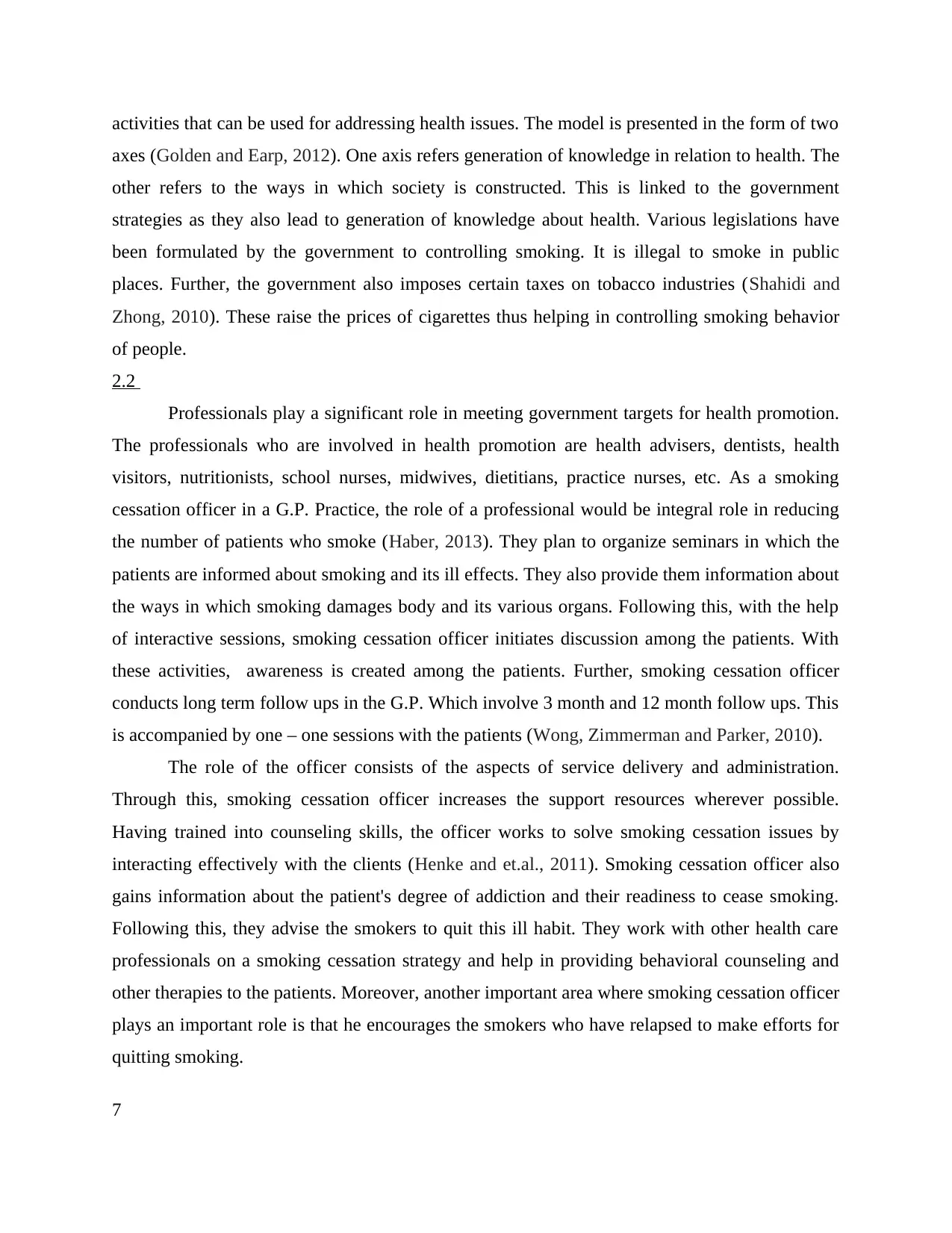
activities that can be used for addressing health issues. The model is presented in the form of two
axes (Golden and Earp, 2012). One axis refers generation of knowledge in relation to health. The
other refers to the ways in which society is constructed. This is linked to the government
strategies as they also lead to generation of knowledge about health. Various legislations have
been formulated by the government to controlling smoking. It is illegal to smoke in public
places. Further, the government also imposes certain taxes on tobacco industries (Shahidi and
Zhong, 2010). These raise the prices of cigarettes thus helping in controlling smoking behavior
of people.
2.2
Professionals play a significant role in meeting government targets for health promotion.
The professionals who are involved in health promotion are health advisers, dentists, health
visitors, nutritionists, school nurses, midwives, dietitians, practice nurses, etc. As a smoking
cessation officer in a G.P. Practice, the role of a professional would be integral role in reducing
the number of patients who smoke (Haber, 2013). They plan to organize seminars in which the
patients are informed about smoking and its ill effects. They also provide them information about
the ways in which smoking damages body and its various organs. Following this, with the help
of interactive sessions, smoking cessation officer initiates discussion among the patients. With
these activities, awareness is created among the patients. Further, smoking cessation officer
conducts long term follow ups in the G.P. Which involve 3 month and 12 month follow ups. This
is accompanied by one – one sessions with the patients (Wong, Zimmerman and Parker, 2010).
The role of the officer consists of the aspects of service delivery and administration.
Through this, smoking cessation officer increases the support resources wherever possible.
Having trained into counseling skills, the officer works to solve smoking cessation issues by
interacting effectively with the clients (Henke and et.al., 2011). Smoking cessation officer also
gains information about the patient's degree of addiction and their readiness to cease smoking.
Following this, they advise the smokers to quit this ill habit. They work with other health care
professionals on a smoking cessation strategy and help in providing behavioral counseling and
other therapies to the patients. Moreover, another important area where smoking cessation officer
plays an important role is that he encourages the smokers who have relapsed to make efforts for
quitting smoking.
7
axes (Golden and Earp, 2012). One axis refers generation of knowledge in relation to health. The
other refers to the ways in which society is constructed. This is linked to the government
strategies as they also lead to generation of knowledge about health. Various legislations have
been formulated by the government to controlling smoking. It is illegal to smoke in public
places. Further, the government also imposes certain taxes on tobacco industries (Shahidi and
Zhong, 2010). These raise the prices of cigarettes thus helping in controlling smoking behavior
of people.
2.2
Professionals play a significant role in meeting government targets for health promotion.
The professionals who are involved in health promotion are health advisers, dentists, health
visitors, nutritionists, school nurses, midwives, dietitians, practice nurses, etc. As a smoking
cessation officer in a G.P. Practice, the role of a professional would be integral role in reducing
the number of patients who smoke (Haber, 2013). They plan to organize seminars in which the
patients are informed about smoking and its ill effects. They also provide them information about
the ways in which smoking damages body and its various organs. Following this, with the help
of interactive sessions, smoking cessation officer initiates discussion among the patients. With
these activities, awareness is created among the patients. Further, smoking cessation officer
conducts long term follow ups in the G.P. Which involve 3 month and 12 month follow ups. This
is accompanied by one – one sessions with the patients (Wong, Zimmerman and Parker, 2010).
The role of the officer consists of the aspects of service delivery and administration.
Through this, smoking cessation officer increases the support resources wherever possible.
Having trained into counseling skills, the officer works to solve smoking cessation issues by
interacting effectively with the clients (Henke and et.al., 2011). Smoking cessation officer also
gains information about the patient's degree of addiction and their readiness to cease smoking.
Following this, they advise the smokers to quit this ill habit. They work with other health care
professionals on a smoking cessation strategy and help in providing behavioral counseling and
other therapies to the patients. Moreover, another important area where smoking cessation officer
plays an important role is that he encourages the smokers who have relapsed to make efforts for
quitting smoking.
7
Paraphrase This Document
Need a fresh take? Get an instant paraphrase of this document with our AI Paraphraser
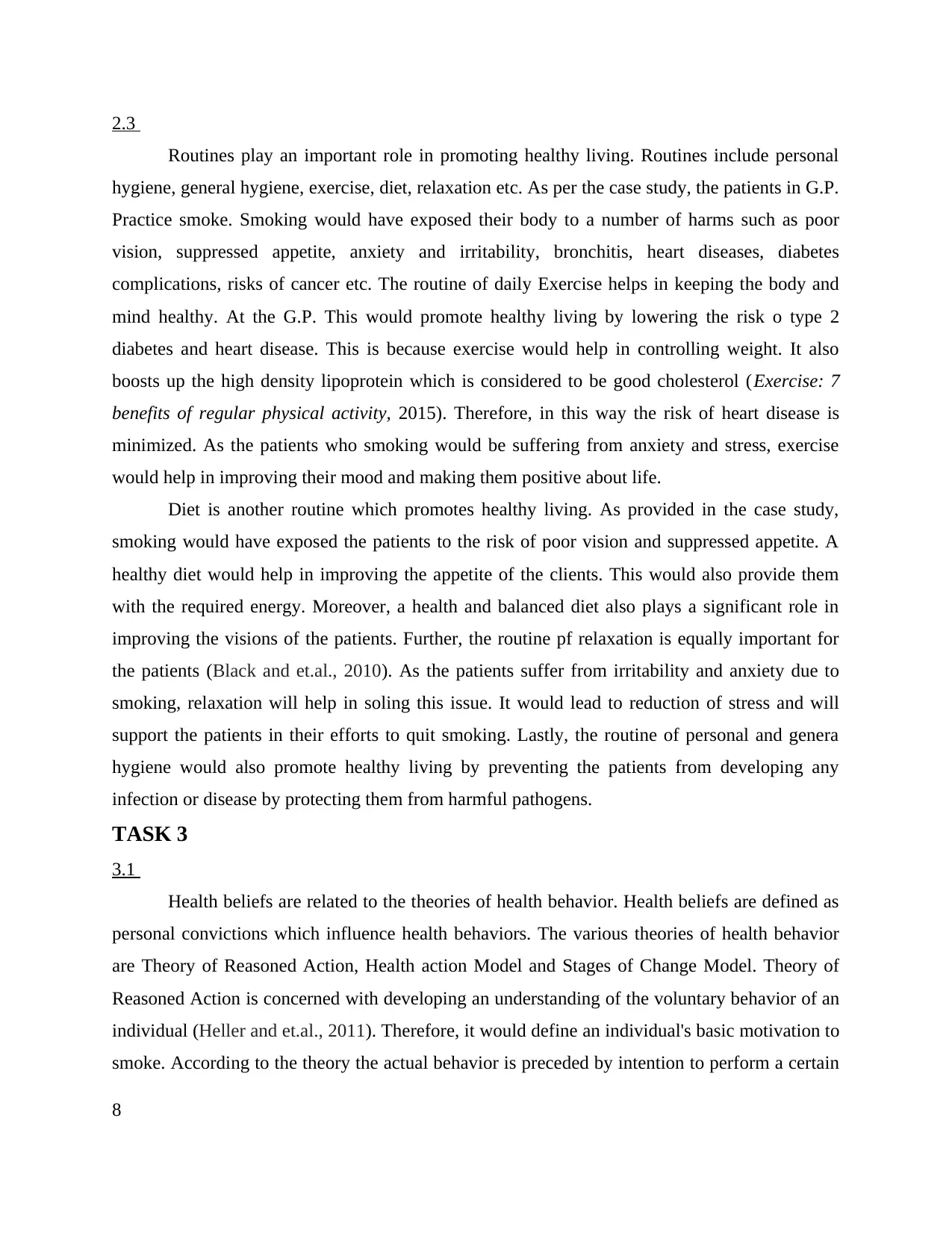
2.3
Routines play an important role in promoting healthy living. Routines include personal
hygiene, general hygiene, exercise, diet, relaxation etc. As per the case study, the patients in G.P.
Practice smoke. Smoking would have exposed their body to a number of harms such as poor
vision, suppressed appetite, anxiety and irritability, bronchitis, heart diseases, diabetes
complications, risks of cancer etc. The routine of daily Exercise helps in keeping the body and
mind healthy. At the G.P. This would promote healthy living by lowering the risk o type 2
diabetes and heart disease. This is because exercise would help in controlling weight. It also
boosts up the high density lipoprotein which is considered to be good cholesterol (Exercise: 7
benefits of regular physical activity, 2015). Therefore, in this way the risk of heart disease is
minimized. As the patients who smoking would be suffering from anxiety and stress, exercise
would help in improving their mood and making them positive about life.
Diet is another routine which promotes healthy living. As provided in the case study,
smoking would have exposed the patients to the risk of poor vision and suppressed appetite. A
healthy diet would help in improving the appetite of the clients. This would also provide them
with the required energy. Moreover, a health and balanced diet also plays a significant role in
improving the visions of the patients. Further, the routine pf relaxation is equally important for
the patients (Black and et.al., 2010). As the patients suffer from irritability and anxiety due to
smoking, relaxation will help in soling this issue. It would lead to reduction of stress and will
support the patients in their efforts to quit smoking. Lastly, the routine of personal and genera
hygiene would also promote healthy living by preventing the patients from developing any
infection or disease by protecting them from harmful pathogens.
TASK 3
3.1
Health beliefs are related to the theories of health behavior. Health beliefs are defined as
personal convictions which influence health behaviors. The various theories of health behavior
are Theory of Reasoned Action, Health action Model and Stages of Change Model. Theory of
Reasoned Action is concerned with developing an understanding of the voluntary behavior of an
individual (Heller and et.al., 2011). Therefore, it would define an individual's basic motivation to
smoke. According to the theory the actual behavior is preceded by intention to perform a certain
8
Routines play an important role in promoting healthy living. Routines include personal
hygiene, general hygiene, exercise, diet, relaxation etc. As per the case study, the patients in G.P.
Practice smoke. Smoking would have exposed their body to a number of harms such as poor
vision, suppressed appetite, anxiety and irritability, bronchitis, heart diseases, diabetes
complications, risks of cancer etc. The routine of daily Exercise helps in keeping the body and
mind healthy. At the G.P. This would promote healthy living by lowering the risk o type 2
diabetes and heart disease. This is because exercise would help in controlling weight. It also
boosts up the high density lipoprotein which is considered to be good cholesterol (Exercise: 7
benefits of regular physical activity, 2015). Therefore, in this way the risk of heart disease is
minimized. As the patients who smoking would be suffering from anxiety and stress, exercise
would help in improving their mood and making them positive about life.
Diet is another routine which promotes healthy living. As provided in the case study,
smoking would have exposed the patients to the risk of poor vision and suppressed appetite. A
healthy diet would help in improving the appetite of the clients. This would also provide them
with the required energy. Moreover, a health and balanced diet also plays a significant role in
improving the visions of the patients. Further, the routine pf relaxation is equally important for
the patients (Black and et.al., 2010). As the patients suffer from irritability and anxiety due to
smoking, relaxation will help in soling this issue. It would lead to reduction of stress and will
support the patients in their efforts to quit smoking. Lastly, the routine of personal and genera
hygiene would also promote healthy living by preventing the patients from developing any
infection or disease by protecting them from harmful pathogens.
TASK 3
3.1
Health beliefs are related to the theories of health behavior. Health beliefs are defined as
personal convictions which influence health behaviors. The various theories of health behavior
are Theory of Reasoned Action, Health action Model and Stages of Change Model. Theory of
Reasoned Action is concerned with developing an understanding of the voluntary behavior of an
individual (Heller and et.al., 2011). Therefore, it would define an individual's basic motivation to
smoke. According to the theory the actual behavior is preceded by intention to perform a certain
8
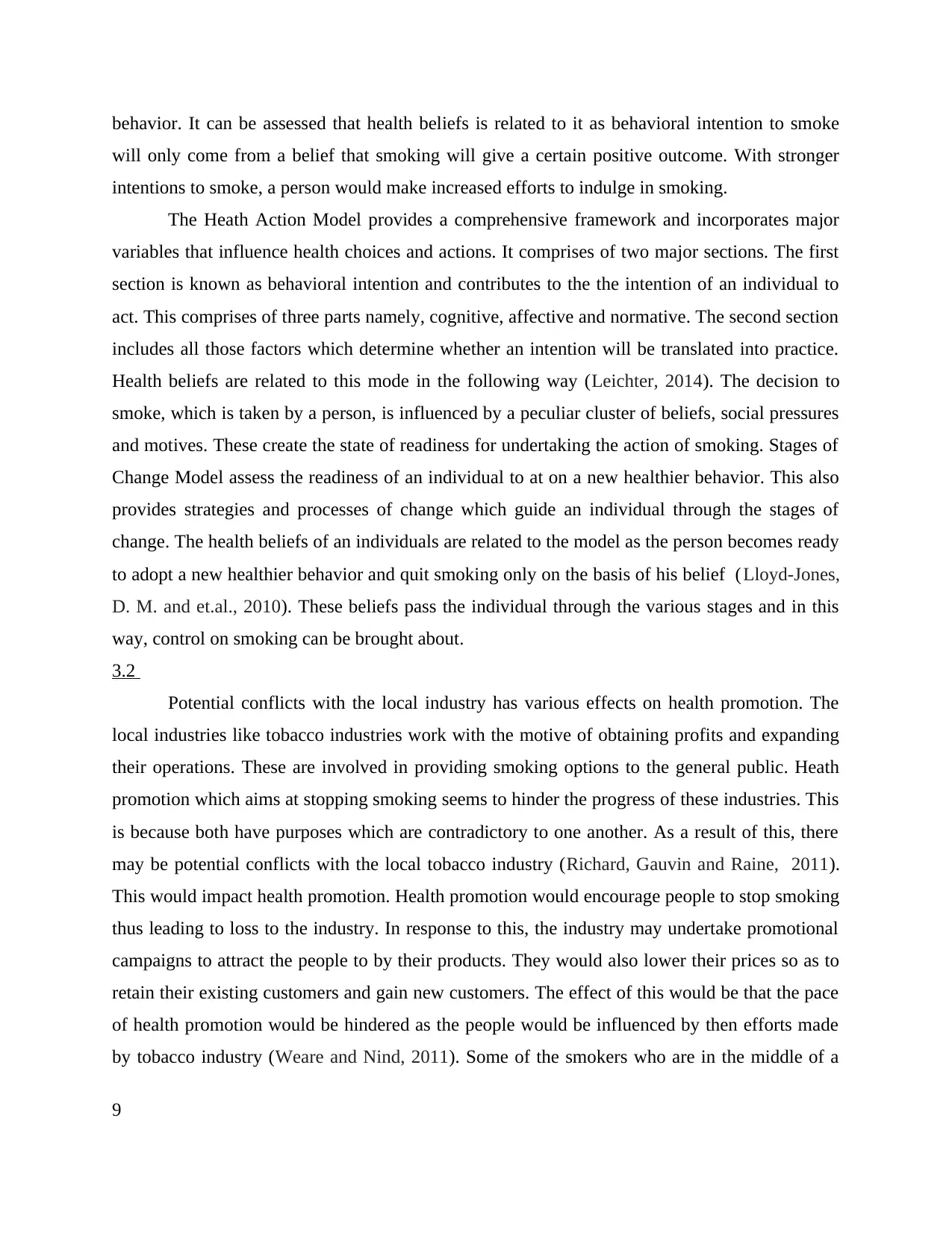
behavior. It can be assessed that health beliefs is related to it as behavioral intention to smoke
will only come from a belief that smoking will give a certain positive outcome. With stronger
intentions to smoke, a person would make increased efforts to indulge in smoking.
The Heath Action Model provides a comprehensive framework and incorporates major
variables that influence health choices and actions. It comprises of two major sections. The first
section is known as behavioral intention and contributes to the the intention of an individual to
act. This comprises of three parts namely, cognitive, affective and normative. The second section
includes all those factors which determine whether an intention will be translated into practice.
Health beliefs are related to this mode in the following way (Leichter, 2014). The decision to
smoke, which is taken by a person, is influenced by a peculiar cluster of beliefs, social pressures
and motives. These create the state of readiness for undertaking the action of smoking. Stages of
Change Model assess the readiness of an individual to at on a new healthier behavior. This also
provides strategies and processes of change which guide an individual through the stages of
change. The health beliefs of an individuals are related to the model as the person becomes ready
to adopt a new healthier behavior and quit smoking only on the basis of his belief (Lloyd-Jones,
D. M. and et.al., 2010). These beliefs pass the individual through the various stages and in this
way, control on smoking can be brought about.
3.2
Potential conflicts with the local industry has various effects on health promotion. The
local industries like tobacco industries work with the motive of obtaining profits and expanding
their operations. These are involved in providing smoking options to the general public. Heath
promotion which aims at stopping smoking seems to hinder the progress of these industries. This
is because both have purposes which are contradictory to one another. As a result of this, there
may be potential conflicts with the local tobacco industry (Richard, Gauvin and Raine, 2011).
This would impact health promotion. Health promotion would encourage people to stop smoking
thus leading to loss to the industry. In response to this, the industry may undertake promotional
campaigns to attract the people to by their products. They would also lower their prices so as to
retain their existing customers and gain new customers. The effect of this would be that the pace
of health promotion would be hindered as the people would be influenced by then efforts made
by tobacco industry (Weare and Nind, 2011). Some of the smokers who are in the middle of a
9
will only come from a belief that smoking will give a certain positive outcome. With stronger
intentions to smoke, a person would make increased efforts to indulge in smoking.
The Heath Action Model provides a comprehensive framework and incorporates major
variables that influence health choices and actions. It comprises of two major sections. The first
section is known as behavioral intention and contributes to the the intention of an individual to
act. This comprises of three parts namely, cognitive, affective and normative. The second section
includes all those factors which determine whether an intention will be translated into practice.
Health beliefs are related to this mode in the following way (Leichter, 2014). The decision to
smoke, which is taken by a person, is influenced by a peculiar cluster of beliefs, social pressures
and motives. These create the state of readiness for undertaking the action of smoking. Stages of
Change Model assess the readiness of an individual to at on a new healthier behavior. This also
provides strategies and processes of change which guide an individual through the stages of
change. The health beliefs of an individuals are related to the model as the person becomes ready
to adopt a new healthier behavior and quit smoking only on the basis of his belief (Lloyd-Jones,
D. M. and et.al., 2010). These beliefs pass the individual through the various stages and in this
way, control on smoking can be brought about.
3.2
Potential conflicts with the local industry has various effects on health promotion. The
local industries like tobacco industries work with the motive of obtaining profits and expanding
their operations. These are involved in providing smoking options to the general public. Heath
promotion which aims at stopping smoking seems to hinder the progress of these industries. This
is because both have purposes which are contradictory to one another. As a result of this, there
may be potential conflicts with the local tobacco industry (Richard, Gauvin and Raine, 2011).
This would impact health promotion. Health promotion would encourage people to stop smoking
thus leading to loss to the industry. In response to this, the industry may undertake promotional
campaigns to attract the people to by their products. They would also lower their prices so as to
retain their existing customers and gain new customers. The effect of this would be that the pace
of health promotion would be hindered as the people would be influenced by then efforts made
by tobacco industry (Weare and Nind, 2011). Some of the smokers who are in the middle of a
9
⊘ This is a preview!⊘
Do you want full access?
Subscribe today to unlock all pages.

Trusted by 1+ million students worldwide
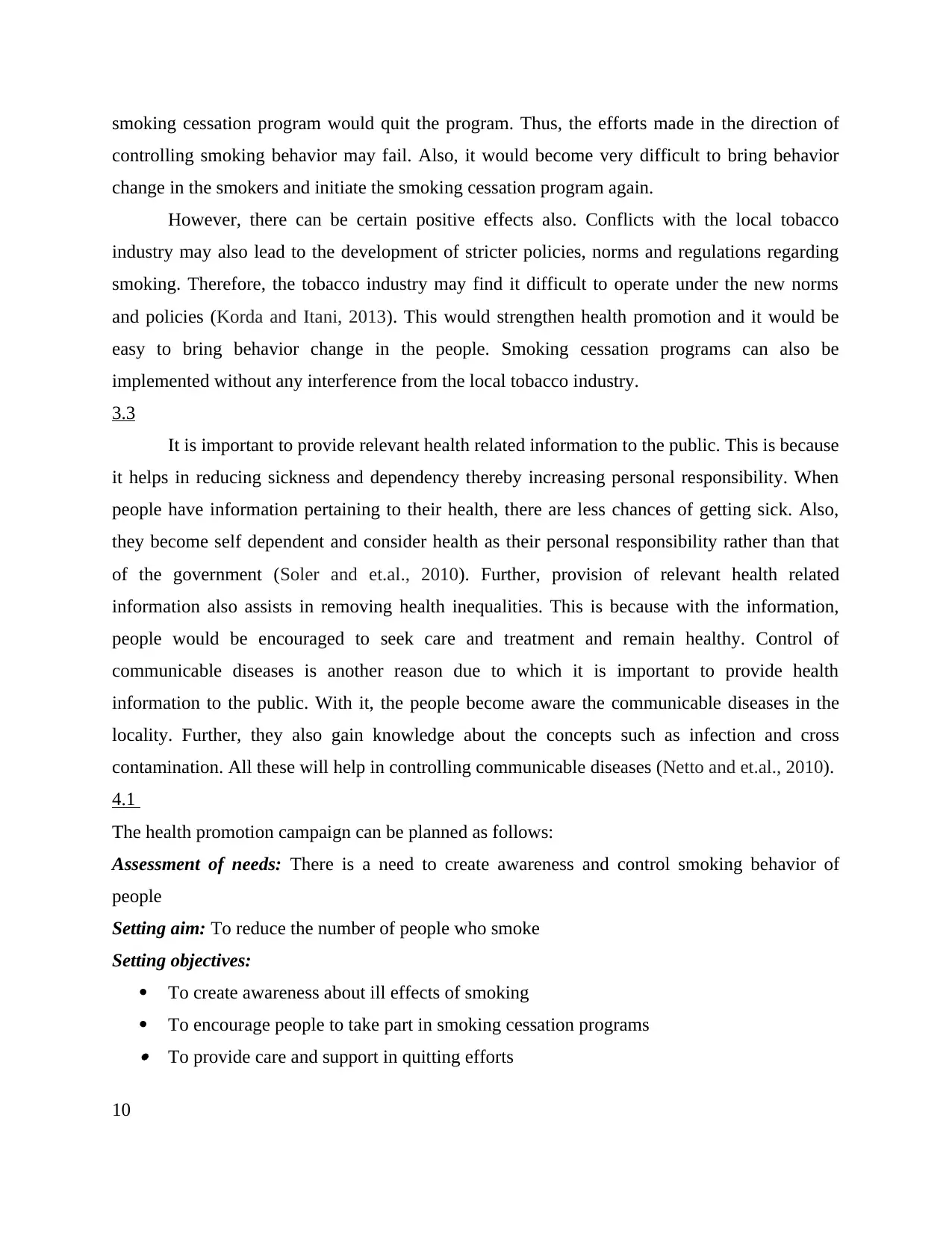
smoking cessation program would quit the program. Thus, the efforts made in the direction of
controlling smoking behavior may fail. Also, it would become very difficult to bring behavior
change in the smokers and initiate the smoking cessation program again.
However, there can be certain positive effects also. Conflicts with the local tobacco
industry may also lead to the development of stricter policies, norms and regulations regarding
smoking. Therefore, the tobacco industry may find it difficult to operate under the new norms
and policies (Korda and Itani, 2013). This would strengthen health promotion and it would be
easy to bring behavior change in the people. Smoking cessation programs can also be
implemented without any interference from the local tobacco industry.
3.3
It is important to provide relevant health related information to the public. This is because
it helps in reducing sickness and dependency thereby increasing personal responsibility. When
people have information pertaining to their health, there are less chances of getting sick. Also,
they become self dependent and consider health as their personal responsibility rather than that
of the government (Soler and et.al., 2010). Further, provision of relevant health related
information also assists in removing health inequalities. This is because with the information,
people would be encouraged to seek care and treatment and remain healthy. Control of
communicable diseases is another reason due to which it is important to provide health
information to the public. With it, the people become aware the communicable diseases in the
locality. Further, they also gain knowledge about the concepts such as infection and cross
contamination. All these will help in controlling communicable diseases (Netto and et.al., 2010).
4.1
The health promotion campaign can be planned as follows:
Assessment of needs: There is a need to create awareness and control smoking behavior of
people
Setting aim: To reduce the number of people who smoke
Setting objectives:
To create awareness about ill effects of smoking
To encourage people to take part in smoking cessation programs To provide care and support in quitting efforts
10
controlling smoking behavior may fail. Also, it would become very difficult to bring behavior
change in the smokers and initiate the smoking cessation program again.
However, there can be certain positive effects also. Conflicts with the local tobacco
industry may also lead to the development of stricter policies, norms and regulations regarding
smoking. Therefore, the tobacco industry may find it difficult to operate under the new norms
and policies (Korda and Itani, 2013). This would strengthen health promotion and it would be
easy to bring behavior change in the people. Smoking cessation programs can also be
implemented without any interference from the local tobacco industry.
3.3
It is important to provide relevant health related information to the public. This is because
it helps in reducing sickness and dependency thereby increasing personal responsibility. When
people have information pertaining to their health, there are less chances of getting sick. Also,
they become self dependent and consider health as their personal responsibility rather than that
of the government (Soler and et.al., 2010). Further, provision of relevant health related
information also assists in removing health inequalities. This is because with the information,
people would be encouraged to seek care and treatment and remain healthy. Control of
communicable diseases is another reason due to which it is important to provide health
information to the public. With it, the people become aware the communicable diseases in the
locality. Further, they also gain knowledge about the concepts such as infection and cross
contamination. All these will help in controlling communicable diseases (Netto and et.al., 2010).
4.1
The health promotion campaign can be planned as follows:
Assessment of needs: There is a need to create awareness and control smoking behavior of
people
Setting aim: To reduce the number of people who smoke
Setting objectives:
To create awareness about ill effects of smoking
To encourage people to take part in smoking cessation programs To provide care and support in quitting efforts
10
Paraphrase This Document
Need a fresh take? Get an instant paraphrase of this document with our AI Paraphraser
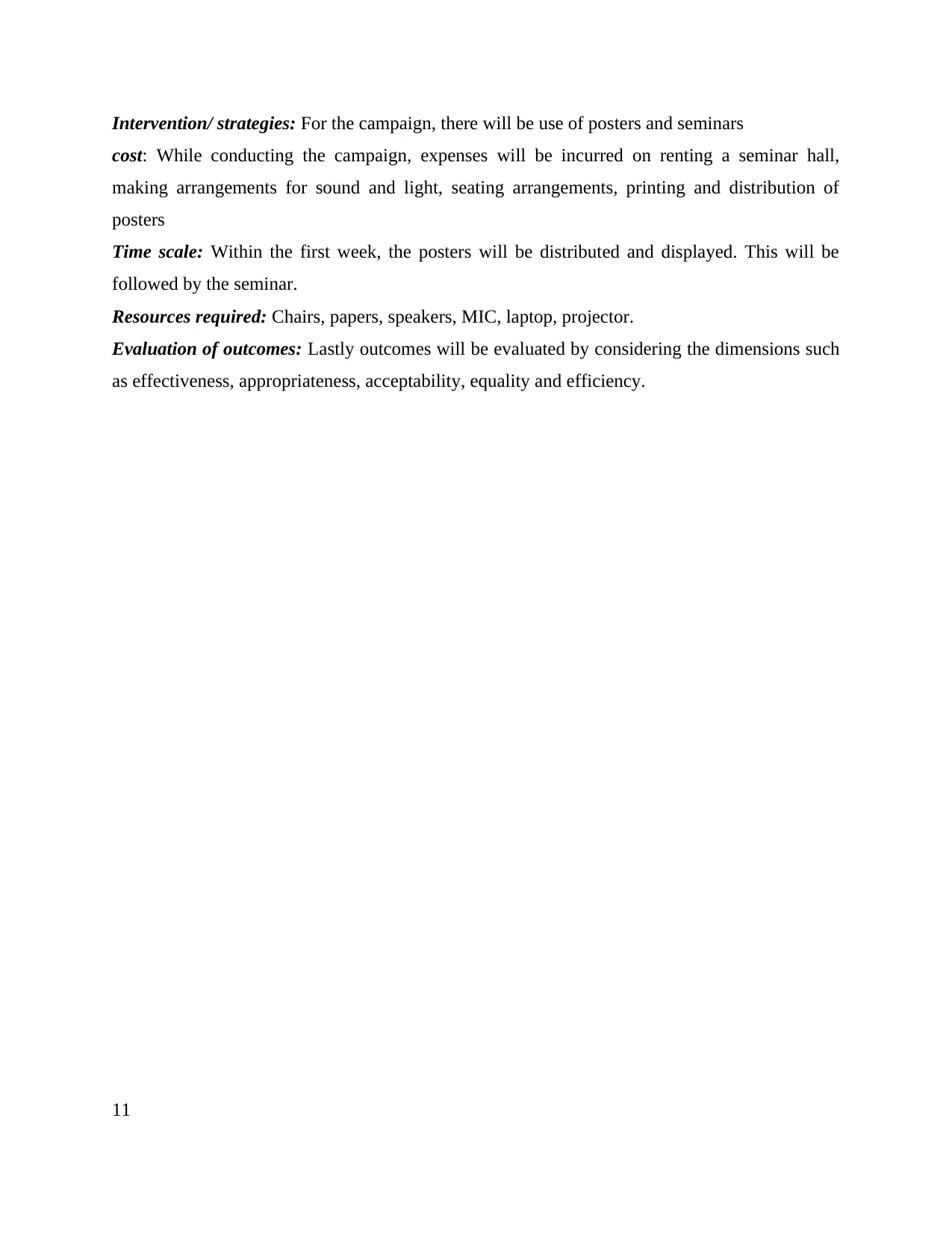
Intervention/ strategies: For the campaign, there will be use of posters and seminars
cost: While conducting the campaign, expenses will be incurred on renting a seminar hall,
making arrangements for sound and light, seating arrangements, printing and distribution of
posters
Time scale: Within the first week, the posters will be distributed and displayed. This will be
followed by the seminar.
Resources required: Chairs, papers, speakers, MIC, laptop, projector.
Evaluation of outcomes: Lastly outcomes will be evaluated by considering the dimensions such
as effectiveness, appropriateness, acceptability, equality and efficiency.
11
cost: While conducting the campaign, expenses will be incurred on renting a seminar hall,
making arrangements for sound and light, seating arrangements, printing and distribution of
posters
Time scale: Within the first week, the posters will be distributed and displayed. This will be
followed by the seminar.
Resources required: Chairs, papers, speakers, MIC, laptop, projector.
Evaluation of outcomes: Lastly outcomes will be evaluated by considering the dimensions such
as effectiveness, appropriateness, acceptability, equality and efficiency.
11
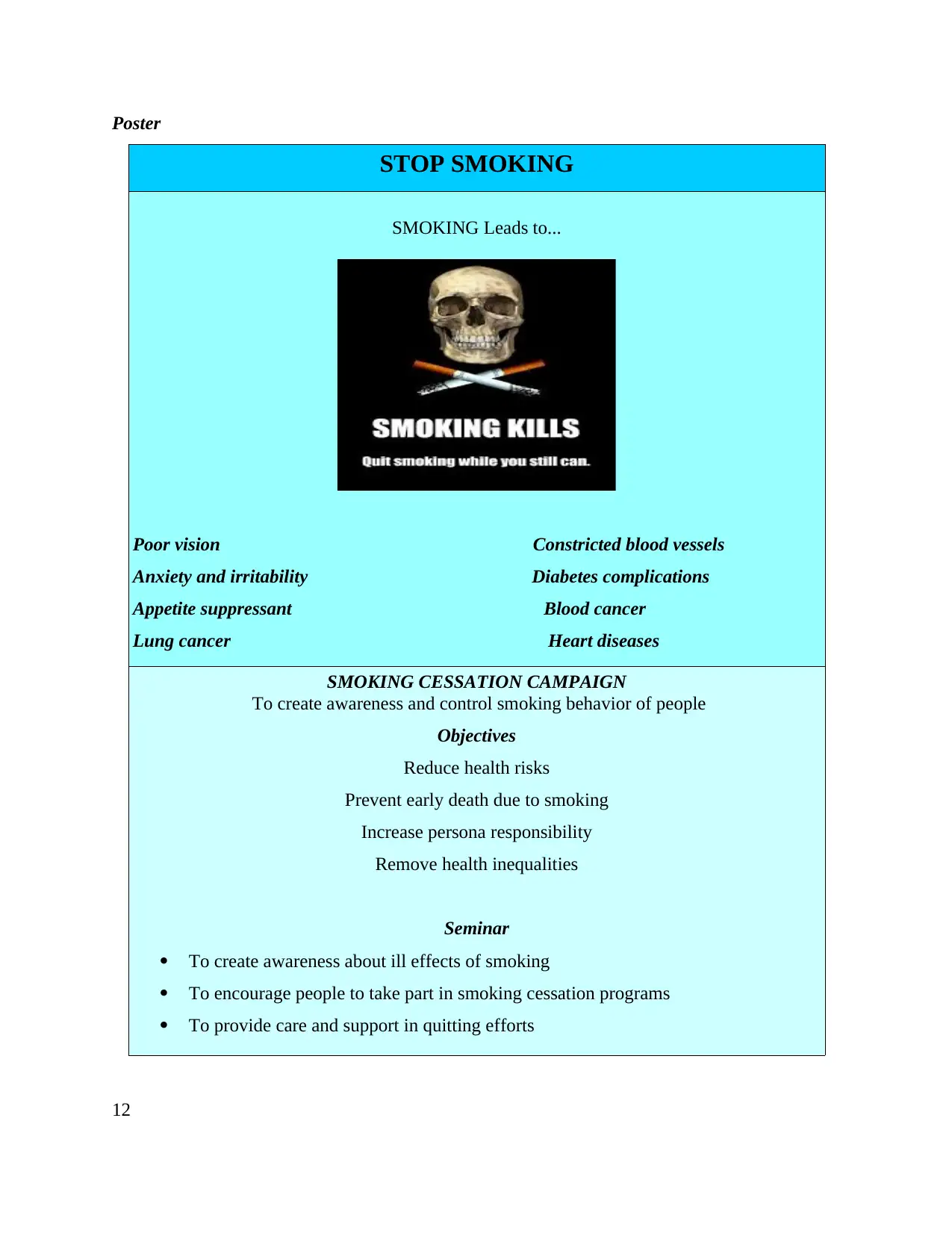
Poster
STOP SMOKING
SMOKING Leads to...
Poor vision Constricted blood vessels
Anxiety and irritability Diabetes complications
Appetite suppressant Blood cancer
Lung cancer Heart diseases
SMOKING CESSATION CAMPAIGN
To create awareness and control smoking behavior of people
Objectives
Reduce health risks
Prevent early death due to smoking
Increase persona responsibility
Remove health inequalities
Seminar
To create awareness about ill effects of smoking
To encourage people to take part in smoking cessation programs
To provide care and support in quitting efforts
12
STOP SMOKING
SMOKING Leads to...
Poor vision Constricted blood vessels
Anxiety and irritability Diabetes complications
Appetite suppressant Blood cancer
Lung cancer Heart diseases
SMOKING CESSATION CAMPAIGN
To create awareness and control smoking behavior of people
Objectives
Reduce health risks
Prevent early death due to smoking
Increase persona responsibility
Remove health inequalities
Seminar
To create awareness about ill effects of smoking
To encourage people to take part in smoking cessation programs
To provide care and support in quitting efforts
12
⊘ This is a preview!⊘
Do you want full access?
Subscribe today to unlock all pages.

Trusted by 1+ million students worldwide
1 out of 15
Related Documents
Your All-in-One AI-Powered Toolkit for Academic Success.
+13062052269
info@desklib.com
Available 24*7 on WhatsApp / Email
![[object Object]](/_next/static/media/star-bottom.7253800d.svg)
Unlock your academic potential
Copyright © 2020–2025 A2Z Services. All Rights Reserved. Developed and managed by ZUCOL.





